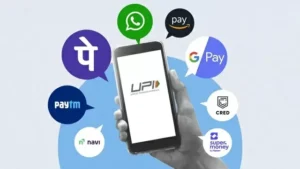Unified Payments Interface (UPI) has revolutionized digital transactions in India, enabling fast, seamless, and secure payments. However, with increasing usage, technical load, and security concerns, the National Payments Corporation of India (NPCI) is introducing new UPI rules starting August 1, 2025. These changes aim to improve efficiency, enhance user protection, and reduce system strain.
Here’s a comprehensive breakdown of all the changes coming your way:
🔄 1. Daily Limit on Balance Checks
UPI apps like PhonePe, Google Pay, Paytm, etc., will now allow a maximum of 50 balance check requests per day per app.
Why? Many apps send automatic balance check signals in the background, overloading bank servers.
Impact: If you frequently check your balance manually or through auto-refresh features, you might hit the limit.
👁️ 2. Limit on Viewing Linked Bank Accounts
Users can now view their linked bank accounts only 25 times a day per UPI app.
This restriction prevents excessive API calls and potential misuse or automated bot attacks.
🔁 3. Changes in AutoPay (Recurring Payments)
Recurring payments such as OTT subscriptions, SIPs, EMIs, and utility bills will now be processed only during off-peak hours, i.e.:
Before 10 AM
Between 1 PM to 5 PM
After 9:30 PM
Why? This scheduling reduces load during high traffic periods and increases transaction success rates.
❌ 4. Restriction on Transaction Status Checks
In case of a failed UPI payment, you can now check the status only 3 times per transaction, and each attempt must be at least 90 seconds apart.
Reason: Avoids excessive load on NPCI/bank systems due to users continuously hitting “Check Status.”
🧾 5. Receiver Name Must Be Clearly Displayed
To curb fraud, UPI apps will now mandatorily show the receiver’s registered bank account name before final confirmation of payment.
Good News: This step helps avoid wrong payments and scams through similar-looking UPI IDs.
🔁 6. Limit on UPI Reversal Requests
Users can raise a maximum of 10 reversal requests per 30 days, and only up to 5 requests can be to the same beneficiary.
Purpose: Prevents abuse of refund systems and fake reversal requests.
📵 7. Inactive UPI IDs Will Be Auto-Deactivated
If a mobile number linked to UPI remains inactive for 12 months, the UPI ID associated with it will be automatically deactivated.
Inactive = No payment, balance check, OTP, or login activity.
Precaution: Keep your UPI accounts active or unlink old/unused mobile numbers.
🔐 8. UPI Fraud Protection and KYC Enforcement
NPCI is enabling intelligent behavior monitoring:
Repeated failed transactions or suspicious activities will trigger auto-KYC verification requests.
High-risk accounts may be flagged or temporarily restricted.
🧠 9. API Call Limits for UPI Apps
UPI apps and banks will now face API rate limits, especially for:
AutoPay requests
Balance check endpoints
Account info retrieval
This ensures fair usage and avoids bank server crashes during peak hours.
⏳ 10. Session Timeout for Idle Transactions
If you stay on the UPI payment screen for too long without confirming, the session will automatically time out.
Helps reduce accidental transactions or misuse if the phone is left unattended.

🛑 Why These Changes Matter
| Feature Affected | New Rule | Impact |
|---|---|---|
| Balance Check | Max 50/day/app | Prevents overload |
| View Linked Accounts | Max 25/day/app | Stops automation abuse |
| AutoPay | Allowed only at off-peak times | Improves reliability |
| Failed Txn Status | Max 3 checks, 90-sec gap | Reduces spam load |
| Receiver Verification | Mandatory name display | Prevents fraud |
| Reversal Requests | 10/month, 5 per person | Prevents misuse |
| Inactive UPI IDs | Auto-disabled after 1 year | Boosts security |
| API Usage | Rate-limited | Stabilizes system |
| KYC Enforcement | Auto-flag suspicious users | Detects fraud early |
| Idle Timeout | Session ends automatically | Prevents mistakes |
✅ What You Should Do Now
Use your UPI account regularly — at least once in a few months.
Update your KYC to avoid restrictions.
Remove inactive mobile numbers from UPI apps.
Set your AutoPay transactions to off-peak times.
Always verify the receiver’s name before paying.
Avoid abusing transaction retries or testing UPI endpoints.
📈 UPI in India: The Scale Behind the Change
Before diving deeper, let’s look at why NPCI is enforcing these changes:
UPI processed over 14 billion transactions in June 2025 alone.
Peak-time failures and overloads have become a growing concern.
Many third-party apps were making excessive background API calls, increasing server traffic for no real user purpose.
Thus, these changes are not just user-focused — they’re about protecting the entire ecosystem.
💬 What Fintech Experts Are Saying
Industry insiders have reacted positively:
“UPI’s scalability depends on balancing openness and control. These new limits are a step in the right direction.”
— Rajeev Chandna, CTO of a leading Fintech firm“By displaying the payee’s bank-registered name, frauds will reduce drastically. It’s a long-awaited feature.”
— Mitali Desai, Digital Banking Analyst🧪 Real-life Scenarios Affected by the Change
Scenario 1: Overactive Balance Check
Ravi checks his bank balance on Google Pay multiple times a day. Post-August 1, if he crosses the 50-check limit, the balance check option will stop working until the next day.
Scenario 2: Forgotten UPI ID
Ritu changed her phone number a year ago and forgot about her old Paytm-linked UPI ID. From August 1, that UPI ID will be auto-deactivated due to inactivity.
Scenario 3: Scheduled EMI Bounce
Akash has scheduled his EMI for 11 AM. But post-August 1, UPI AutoPay won’t work during that peak hour, and the payment will be rescheduled.
🌐 UPI and Global Expansion
NPCI is pushing UPI internationally with tie-ups in:
UAE
Singapore
France
Nepal
Sri Lanka
These changes not only streamline local usage but also prepare UPI to meet global payment standards in real time security, compliance, and infrastructure.
🧰 Pro Tips for UPI Users
Tip Benefit Use only trusted UPI apps (PhonePe, GPay, BHIM, etc.) Avoid fraud Turn off background refresh in UPI apps Reduces hidden API use Don’t click on unknown UPI links Prevent phishing Use app-level locks (PIN, biometrics) Added security Regularly relink or remove inactive bank accounts Prevent account errors 📚 Frequently Asked Questions (FAQs)
🔹 Q1: Will these limits affect normal users?
No. If you’re a casual user making normal transactions, you’re unlikely to hit these limits.
🔹 Q2: Can I increase the limit for balance check?
No. The limit is set by NPCI and applies to everyone uniformly.
🔹 Q3: What happens if my UPI ID gets deactivated?
You can reactivate it through your UPI app by linking your mobile number again and redoing KYC.
🔹 Q4: Will my scheduled subscriptions fail now?
Not if you reschedule them to fit within the new AutoPay time window (before 10 AM, 1–5 PM, after 9:30 PM).
✅ Benefits of UPI Changes from August 1, 2025
The new rules introduced by NPCI are not just limitations — they are strategic improvements to ensure UPI remains safe, fast, and future-ready. Here’s how these changes will benefit users, banks, and the overall system:
🔒 1. Enhanced Security
Limiting the number of balance checks, status requests, and reversal attempts will reduce the risk of misuse, bots, and fraud.
Displaying the receiver’s full name before payment adds a strong layer of verification, preventing wrong or scam payments.
🚀 2. Faster and More Reliable Transactions
By scheduling AutoPay and bulk payments during off-peak hours, UPI networks will experience less congestion.
This means fewer transaction failures, especially for EMIs, subscriptions, and bill payments.
⚙️ 3. Reduced System Load
Automatic background balance checks and excessive API calls often clog bank servers.
These limits will ensure smoother performance and better app stability, especially during festivals and peak hours.
🧠 4. Smarter Fraud Detection
NPCI’s new behavior monitoring system can detect suspicious activity in real time, flagging fake users or automation attempts.
Suspicious accounts will be required to re-verify their KYC, increasing overall platform trust.
📊 5. Transparency and Accountability
Showing the receiver’s registered name before completing a transaction increases user confidence.
Users can now track their limits and usage clearly, promoting awareness and responsible usage.
📉 6. Fewer Failed or Duplicate Transactions
With limits on status retries and timeout sessions, users won’t accidentally spam the system or cause duplicate debits.
This will lower customer complaints and make support faster for genuine issues.
🌍 7. Preparing UPI for Global Use
These changes align with international payment standards, making UPI more robust for global partnerships with countries like UAE, France, and Singapore.
🛡️ 8. Protection Against Forgotten or Abandoned UPI IDs
Auto-deactivation of UPI IDs linked to inactive numbers ensures your old accounts can’t be misused.
This is especially helpful if you’ve changed your mobile number or closed a bank account.
💡 Conclusion: A Safer, Smarter UPI Experience
These changes aren’t restrictions — they’re upgrades for a growing digital economy. By introducing control, transparency, and better security, NPCI ensures that UPI can scale globally while staying user-friendly and fraud-resistant.


